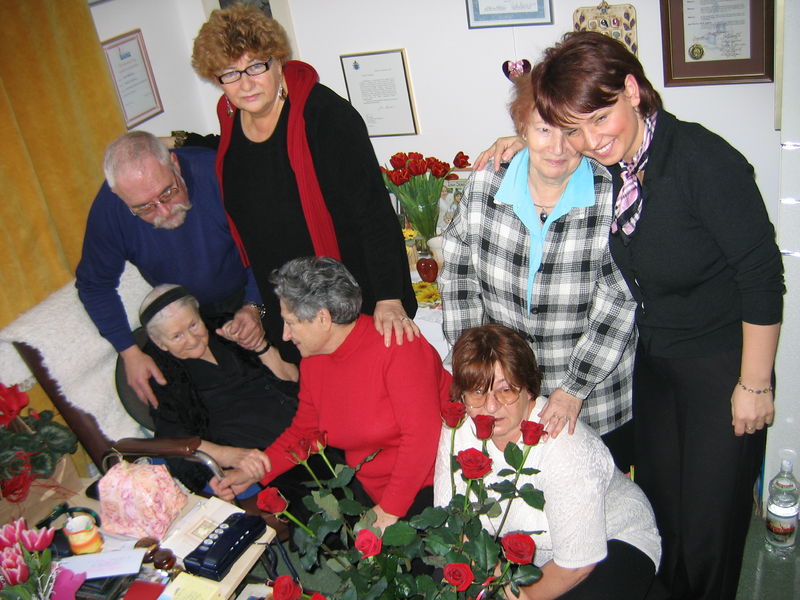Bless the Lady Plumber
Irena Sendler
Remember this lady?
Sendler, a Roman Catholic, was born in Otwock, outside Warsaw, on February 15, 1910. Her father was a physician who directed a spa hospital. Sendler remembered him as someone who taught great compassion: “If you see someone drowning, you must try to rescue them, even if you cannot swim.”
She was an administrator in Warsaw’s welfare department in 1940, when Nazi Germany occupied Poland. Nearly half a million Jews were sequestered in Warsaw’s tiny ghetto, where conditions were appalling. The Nazis ordered a stop to normal social services, such as food and health care. Charged with warding off typhus and tuberculosis, Sendler had official permission to move freely in the ghetto. She convinced Jewish parents to let her hide their children. She used an ambulance to smuggle children in burlap sacks and coffins. A dog seated next to her would sometimes bark to drown out the children’s cries. She received aid from the Zegota, the Polish Council to Aid the Jews.
Died: May 12, 2008 (aged 98)
Warsaw , Poland
my source: an e-mail
During WWII, Irena, got permission to work in the Warsaw ghetto, as a Plumbing/Sewer specialist. She had an ulterior motive.
Irena smuggled Jewish infants out in the bottom of the tool box she carried. She also carried a burlap sack in the back of her truck, for larger kids
Irena kept a dog in the back that she trained to bark when the Nazi soldiers let her in and out of the ghetto.
The soldiers, of course, wanted nothing to do with the dog and the barking which covered the kids/infants noises.
Irena Sendler of the Chasidei Umos HaOlam
by guest blogger
Yad Vashem was established in 1953 by Israel's Remembrance Authority with the stated mission of honoring the Chasidei Umos HaOlam. As part of their answer to the dilemma of how to memorize the victims Yad Vashem established a program which honors the Righteous Among the Nations -- gentiles who put their lives at risk to rescue Jews.
Over the years Yad VaShem has honored tens of thousands of people including, in 1965, a Polish woman by the name of Irena Sendler. Sendler is credited with having saved over 3000 Jewish lives, almost two thirds more than the more well-known Oskar Schindler of "Schindler's List" renown.
In 1999 a group of students from Kansas City researched the events surrounding Sendler's activities, documented their findings and actually met with the then-98-year-old Sendler before creating a project "Life in a Jar" which relates the Irena Sendler story.
Irena Sendler was a young social worker in Poland when the Germans invaded in 1939. She joined the Zagota -- a Polish underground group that specialized in assisting Jews. Over the course of the first two years of the war Sendler helped forge documents and locate hiding places for Jews who were fleeing the Nazis -- accounts estimate that she helped over 500 Jews escape from the Nazis.
In 1941 Sendler obtained false documents which identified her as a nurse. She was able to enter the Warsaw Ghetto with food and medicines but once she saw the situation in the ghetto Sendler's mission turned into what she could bring out of the ghetto rather than what she could bring in. She realized that the Nazis intended to murder the Jews and she felt that the best chance for saving lives lay in removing as many children from the ghetto as possible. Sendler began to smuggle children out of the ghetto, picking up orphans from the street and bringing them out by sedating them and ferrying them in luggage, bags, toolboxes, and even under carts filled with garbage.
Sendler then began to go door to door in the ghetto. She begged parents to allow her to take their children. This was traumatic for the parents, who had to decide where their children's best chance of survival lay, and also for Sendler herself who later told historians "I talked the mothers out of their children" Sendler described the heartwrenching scenes that she experienced, day after day, as she took children from their families. "Those scenes over whether to give a child away were heart-rending. Sometimes, they wouldn't give me the child. Their first question was, 'What guarantee is there that the child will live?' I said, 'None. I don't even know if I will get out of the ghetto alive today."
As perilous as smuggling the children out of the ghetto was -- via a secret passage through the Old Courthouse that stood on the edge of the ghetto, under tram seats and even through the sewer pipes that ran under the city -- the next part of the rescue operation was just as difficult. Sendler and her Zagota comrades had to forge documents for the children and find suitable hiding places for them. Many children were placed in convents or orphanages while others were hidden with sympathetic Polish families.
Jewish children in a Polish convent 1943
Sendler carefully recorded the names of the children on tissue paper which she then closed in glass jars and buried in her neighbor's garden. She wanted to ensure that, after the war, the children could be reunited with their families if possible or, if not, at least with their Jewish community.
In October 1943 Sendler was arrested by the Germans who interned her in the infamous Pawiak prison. Throughout the torture which included breaking both of her legs Sendler never divulged any information about "her" children. Zagota members obtained her release by bribing a guard just as Sendler was being led to her execution. She lived out the rest of the war in hiding.
In addition to the 1965 Yad Vashem commemoration Sendler was honored by the Life in a Jar project run by the LMC. Life in a Jar includes a book, a website and a performance which has been viewed by audiences throughout the world.
Irena Sedler with survivors
my source: the e-mail
In 2007 Irena was up for the Nobel Peace Prize. She was not selected. Al Gore won, for a slide show on Global Warming.
Later another politician, Barack Obama, won for his work as a community organizer for ACOR
In MEMORIAM - 65 YEARS LATER
I'm doing my small part by forwarding this message. I hope you'll consider doing the same. It is now more than 67 years since the Second World War in Europe ended.
This e-mail is being sent as a memorial chain, In memory of the six million Jews, 20 million Russians, 10 million Christians and 1,900 Catholic priests who were murdered, massacred, raped, burned, starved and humiliated!
Now, more than ever, with Iran, and others, claiming the HOLOCAUST to be 'a myth', it's imperative to make sure the world never forgets, because there are others who would like to do it again.
This e-mail is intended to reach 40 million people worldwide!
Join us and be a link in the memorial chain and help us distribute it around the world.
Please don't just delete it.. It will only take you a minute to pass this along.
my source: NBC News
my source: NBC News
WARSAW, Poland – Elzbieta Ficowska leaned forward to place red roses on a new grave in Warsaw's Powawazki Cemetery. The 66-year-old woman also lit two votive candles.
They were in memory of Irena Sendler, the person to whom she owes her very existence.
'A truly heroic act'
Ficowska was spirited out of the ghetto in a wooden carpenter's box when she was just six months old. Hidden on a truck beneath a pile of bricks – arranged to allow air to reach her – she had been drugged to prevent her from crying. With her in the box was a silver spoon engraved with her name and date of birth, probably put there by the mother she never knew.
"It was a truly heroic act for my mother to give away her baby with no guarantee it would survive," Ficowska said. "That was the painful decision my mother made." She did so because thousands of Jews were being sent each day to the gas chambers at Treblinka and other death camps in occupied Poland.
The infant girl was brought to Stanislawa Bussoldowa, a Roman Catholic midwife who also delivered the babies of Jewish women in hiding. Bussoldowa, a member of Sendler's clandestine network, adopted Ficowska and raised her as a Catholic.
The only physical trace of Ficowska's rescue is the spoon, which she keeps in a dark-blue velvet box on her mantle piece next to a photograph of her late husband, Jerzy, a poet.
But there are other reminders, she says, one of which is her life-long fear of close spaces. "That's why I think I'm so claustrophobic," she said, reflecting on having been hidden in the wooden box. "I'm always opening windows and doors wherever I go."
Professor Michael Glowinski in his Warsaw apartment.
'She saved my mother's life'
Another survivor saved by Sendler's heroic acts took a different path.
Professor Michal Glowinski, 74, always knew he was Jewish. When he was eight, he was taken out of the ghetto with his parents by a German soldier who had been bribed.
He recalls his childhood with intense clarity. "The color of the ghetto is the color of the paper that covered the corpses lying on the street before they were taken away," he wrote in his memoir, "Black Seasons." The book is a blend of two voices – that of Glowinski as a young child and as an adult.
We recently spoke in his narrow living room, the shelves crammed with books and scholarly journals. A professor of literature at the Polish Academy of Sciences in Warsaw, he described with animation how he and his mother pursued a tortuous escape route to avoid capture by the Gestapo.
Sendler eventually found his mother a job as a maid, using forged identity papers. "She saved my mother's life," Glowinski said. At the same time, Zegota, the umbrella organization of Sendler's underground railroad, arranged for him to be placed in an orphanage in eastern Poland where he was protected by impoverished nuns. Glowinski's father, meanwhile, found work as a day laborer, part of a deliberate plan to separate the family in hope of improving their individual chances of survival.
'Dominant element of my life'
In the orphanage, Glowinski said, he shut out the world that had existed before, never expecting his family to be reunited. He prepared himself only for bad news.
"I had grown deadened and indifferent," he wrote in his memoir. As a result, he did not rejoice when his mother came for him suddenly in February of 1945. His father also survived the war, and the whole family was reunited later that year. Glowinski revived the love for his parents he had smothered as a defense mechanism during the war and even dedicated his memoir, "Black Seasons," to his mother and father.
But, his experience during the Holocaust still affects him deeply.
"If one spends his life in the ghetto and then hiding, locked in a closet or in a stack of potatoes, his whole life is marked by that experience," he said. "It is the dominant element of my life that puts everything else in perspective. The childhood trauma remains the most important element of my biography."
Glowinski and Ficowska are just two of the thousands of Jews who are the beneficiaries of Sendler's heroism. Her far-reaching legacy extends to today's children.
"If she didn't save you," Ficowska's 10-year-old grandson, Karol, told his grandmother, "my mother would not be here, and I wouldn't be here either."
Don Snyder was a longtime NBC News Producer who is now retired and is a freelance writer.












No comments:
Post a Comment